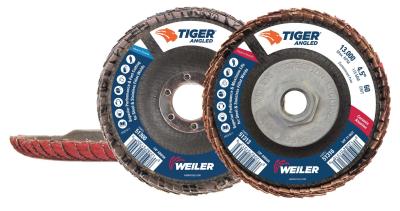
Weiler Abrasives Group has added a new flap disc to its Tiger coated abrasives lineup. New Tiger Angled flap discs deliver aggressive grinding and long life, along with greater flexibility for grinding fillet welds, T-joints, hard-to-reach places, and for repair and rework, according to the company. They are ideal for grinding steel, stainless steel, aluminum and other hard-to-grind metals, without wearing prematurely.
The Tiger Angled flap discs feature a 90-degree angled flap design that allows the operator to grind at a higher or lower angle, along with a phenolic backing that provides stability to the flaps. This combination optimizes flap-to-metal contact, resulting in better feel and control for the operator during grinding and finishing. In addition, the angled flaps reduce the risk of gouging the workpiece while grinding fillet welds for a smoother finish.
Because Tiger Angled flap discs remove more metal in less time, operators can get the job done faster. Tiger Angled flap discs reportedly remove more material in one minute—and over the life of the disc—than competitive products, lowering the overall cost to use.
Tiger Angled flap discs are available in 7/8-inch arbor or with a 5/8-inch -11 nut for fast changeover.
Weiler offers Tiger Angled in both a ceramic flap disc and a zirconium flap disc. Both grain types offer a contaminant-free option for stainless steel applications. In addition, the ceramic alumina version features a top coat that grinds cooler to protect valuable parts and prevents loading on softer alloys such as aluminum. The zirconia alumina option features self-sharpening grains that deliver aggressive grinding and long life.
Contact Details
Related Glossary Terms
- alloys
alloys
Substances having metallic properties and being composed of two or more chemical elements of which at least one is a metal.
- arbor
arbor
Shaft used for rotary support in machining applications. In grinding, the spindle for mounting the wheel; in milling and other cutting operations, the shaft for mounting the cutter.
- backing
backing
1. Flexible portion of a bandsaw blade. 2. Support material behind the cutting edge of a tool. 3. Base material for coated abrasives.
- fillet
fillet
Rounded corner or arc that blends together two intersecting curves or lines. In three dimensions, a fillet surface is a transition surface that blends together two surfaces.
- grinding
grinding
Machining operation in which material is removed from the workpiece by a powered abrasive wheel, stone, belt, paste, sheet, compound, slurry, etc. Takes various forms: surface grinding (creates flat and/or squared surfaces); cylindrical grinding (for external cylindrical and tapered shapes, fillets, undercuts, etc.); centerless grinding; chamfering; thread and form grinding; tool and cutter grinding; offhand grinding; lapping and polishing (grinding with extremely fine grits to create ultrasmooth surfaces); honing; and disc grinding.
